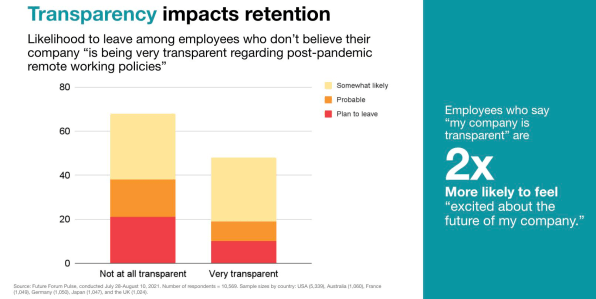The Great Resignation antidote that costs companies nothing
Companies have been grappling with internal transparency for decades. How much visibility should employees be given regarding key developments and decisions impacting them and the business? And how much input should leaders solicit from employees on these issues?
After nearly two years of unprecedented disruption and uncertainty—and the ongoing Great Resignation—transparency at work has never been more critical. It’s essential to bring challenges and opportunities to the forefront and to instill trust in the leadership and direction of an organization. Perhaps most importantly, according to Future Forum’s Pulse survey, it’s also key to retaining talent. In companies where leaders are not perceived to be transparent, twice as many employees are likely or very likely to leave.

The question of whether employees will be required to return to the office and how often has brought the issue of transparency in the workplace to a head. Executives across industries acknowledge that employees want flexibility, but they also admit that there’s a disconnect between themselves and employees on how to move forward. All told, according to our research, two-thirds of companies are not engaging employees in planning around the future of work. And when we have conversations with external executives on this topic, we often hear things like, “Our employees aren’t listening to us” or “They are over-surveyed” or “If we give them an opportunity to voice what they want, we will then have to give it to them” or “We shouldn’t communicate until we have the answers.”
All these conclusions are wrong. Transparency can’t be a top-down edict. It must be a two-way street. That means involving employees in the planning process in a meaningful way, even if you don’t have all the answers, and listening deeply to their feedback and ideas.
To start, think about conversations that have become unnecessarily exclusive to leaders, and see if you can open them up in some way, like regular Q&A sessions with executives or a dedicated “Ask Me Anything” channel. For example, one CEO we spoke with personally held daily all-staff sessions for the first seven months of the pandemic. Enlist working groups of employees across functions, geographies, and demographics to help solve problems, or experiment with crowdsourcing new ideas. Sometimes (oftentimes), the best ideas don’t come from where you’d expect, and involving employees in this way will increase engagement and, by extension, retention.
All well and good, executives may say, but how do you keep things from going off the rails? This shouldn’t be an unstructured and unrestrained free for all. For two-way communication to work, there must be well-paved lanes going in both directions—with guardrails, shoulders, speed limits, and seatbelts. Try out these rules of the road: Set the tone from the top, and clearly communicate expectations around mutually respectful behavior; establish and publicly share your process for triaging challenging conversations; acknowledge open questions and, if you can, commit to a time frame to respond; and default to accountability, so anonymity is the exception rather than the rule.
The crossroads we find ourselves at today also present an opportunity for executives to take a good, hard look in the mirror. Many senior executives have spent too much time in a protected communication bubble where messages reach them only after many rounds of presentation revisions and pre-meetings, and messages from them are only shared after rounds of editing. This insulation has caused executives to lose touch with the day-to-day realities of their people. Additionally, study after study shows that the more power a leader has, the more difficult it is for them to relate to subordinates. Empathy at this level isn’t a born trait—building that muscle requires intentional and sustained work. The good news is that leaders who commit to figuring out the future of work together with their teams will have plenty of opportunity to exercise their empathy, transparency, and listening muscles.
Leaders who understand the power of transparency see this as a moment of opportunity. Employees who say their company is transparent report feeling more satisfied, valued, and fairly treated in their jobs. Creating a culture of thoughtful dialogue in both directions will lead to trust, mutual respect, and more committed employees—ultimately helping leaders build stronger companies.
Brian Elliott is a senior vice president at Slack and the executive leader of the Future Forum, a new consortium backed by Slack, dedicated to helping companies transform in a digital-first world. Debbie Lovich is managing director and senior partner at Boston Consulting Group.
Fast Company , Read Full Story
(12)



